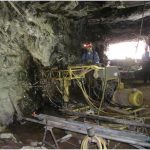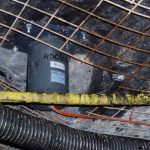In 2016–17, AAI completed drilling, instrumentation, and overcore in-situ stress measurements for HDR at the Duke Energy Walters concrete arch dam located on the Pigeon River in western North Carolina. The investigation was conducted under the oversight of the Federal Energy Regulatory Commission and an Independent Board of Consultants. Tasks completed included:
- Development of a detailed Work Plan, Health and Safety Plan, and project schedule
- 762 feet of HQ and 6-inch-diameter coring in five vertical and two angled holes
- 41 USBM BDG 2D stress measurements
- 30 CSIRO HI Cell 3D stress measurements
- 5 Sigra 2D stress measurements
- Installation of two temperature probes, two inclinometers, and one MPBX
- Borehole permeability testing
- Hole and instrument grouting with low-alkali, non-shrink Type II grout
- OCI-40 optical and acoustic borehole logging (conducted by COLOG)
- Core logging, photography, and preservation
- Delivery of a comprehensive project report with logs, raw data, and analytical results
Drilling was conducted on the non-overflow sections of the dam and on the dam spillway 180 feet below the crest. Difficult access conditions required placing drilling equipment with a high-lift crane and use of a barge to access remote sections of the dam.
Drilling was completed using AAI’s Ingetrol 75E electric-hydraulic drill mounted on a specially-modified narrow track frame to allow access to constricted areas of the dam. Drilling into the face of the dam was conducted through a special valved stuffing box as a precaution to shut in water flow in the event of a dam breach.
All drilling was conducted using redundant environmental containment systems to prevent contamination of water sources. Biodegradable food-grade oil was used in all drilling equipment.
Excellent intact core samples suitable for testing were achieved through the concrete-bedrock interface at the base of the dam.
Stress measurements were conducted using three different overcoring techniques. Excellent agreement was achieved between the methods. The Sigra method, which utilizes an onboard data logger instead of a cable to store strain relief measurements during overcoring, allowed measurements to reach to the deepest parts of the dam, thereby producing a unique and complete vertical stress profile though the dam.
Resulting stress measurements provided HDR with key baseline input for 3D finite-element structural modeling of the dam.






